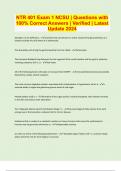Resume
Samenvatting Comparative Analysis of Political Institutions (CAPI)
- Cours
- Établissement
- Book
Bondige samenvatting van het vak Comparative Analysis of Political Institutions. Het boek zelf is nogal dik, zeker in combinatie met bijbehorende artikelen. Deze samenvatting geeft de belangrijke punten van het boek, de extra artikelen en de hoorcolleges helder weer in slechts 21 pagina's.
[Montrer plus]





